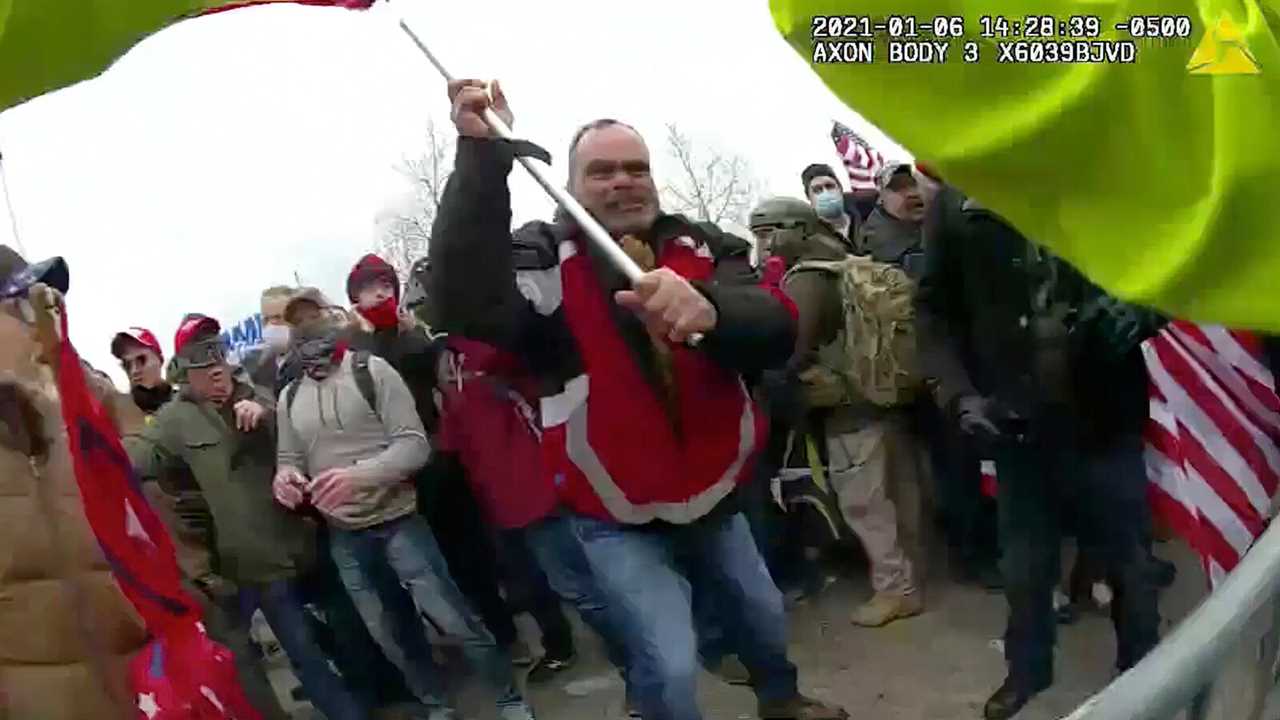
Among the many violent scuffles that erupted during the riot at the Capitol, this one stood out.
On one side of the barricade was a lightly armored Washington, D.C., police officer, standing with his colleagues to defend the building against a mob of Trump supporters. Confronting him from the other side, brandishing a flagpole, was not just any assailant, but a retired member of the New York Police Department.
In their brief encounter on the front lines of the riot, the former officer, Thomas Webster, beat his on-duty compatriot with the flagpole several times, prosecutors say, then pushed through the barricades and tackled him to the ground. In answering these charges, Mr. Webster has raised a bold defense: He has claimed that the officer provoked his aggression and that he was simply trying to protect himself.
On Tuesday, Mr. Webster’s trial began in Federal District Court in Washington — the sixth case connected to the Capitol attack to go on trial. While several defendants charged in the riot have said they plan to argue self-defense, Mr. Webster is the first to test the strategy on a jury.
By focusing on a former officer accused of attacking someone else in law enforcement, the Webster case will inevitably revolve around one of the ironies revealed on Jan. 6, 2021, when hundreds of rioters stormed into the Capitol and delayed lawmakers as they were certifying the results of the 2020 presidential election.
Many in the crowd that day proclaimed themselves supporters of the police in the “Back the Blue” vein. But scores of people have been charged with assaulting law enforcement officers — with their fists and with a variety of weapons, including hockey sticks, baseball bats, metal batons and bear spray. Prosecutors say that nearly 150 officers were injured.
Mr. Webster, a 54-year-old former Marine, was no ordinary officer: He once served on the personal security detail for Mayor Michael R. Bloomberg of New York. After he turned himself in to the authorities last year, some of his former colleagues were surprised to hear that he had erupted into violence at the Capitol. One described him as “just one of the guys.”
From the outset, though, Mr. Webster’s past life as an officer has played a central role in the investigation and prosecution of his case. At a hearing in June to determine his bail, Judge Amit P. Mehta could not seem to believe that Mr. Webster had found himself in such a predicament.
“Lots of folks come before me,” the judge said. “I’m mystified by their conduct. But your conduct in particular, it’s hard to get my head around. You were a police officer. You should know better.”
In an interview with the F.B.I. in February 2021, Mr. Webster told agents that he had gone to Washington on Jan. 6 to show support for President Donald J. Trump and to protest what he believed was a stolen election. He claimed that when he walked with the crowd from Mr. Trump’s speech near the White House to the Capitol, the “crazy” riot at the building was already underway.
Speaking with the F.B.I., Mr. Webster acknowledged being “vocal” and “upset” that day. But he also claimed that one officer in particular — identified by his initials, N.R. — encouraged him to “jump over the barrier” in what Mr. Webster described as a “barroom type of moment.”
Capitol Riot’s Aftermath: Key Developments
Trump allies’ involvement. Newly disclosed testimony and text messages showed how closely Mark Meadows, the former chief of staff for President Donald J. Trump, and fervent pro-Trump members of Congress worked together on efforts to overturn the election and encourage Trump supporters to march to the Capitol on Jan. 6.
By Mr. Webster’s account, Officer N.R. struck first.
“I got hit with a freight train in my face,” Mr. Webster told the F.B.I., calling the blow a “big sucker punch.”
Prosecutors are expected to offer a different version of events. In the weeks leading up to the trial, they provided evidence that Mr. Webster went to Washington “armed and ready for battle,” with body armor, a map of the area and military rations similar to those that soldiers eat in the field. They also said that Mr. Webster brought his handgun with him from New York, though they acknowledge that he left it in his hotel room.
At the trial this week, the jury is likely to hear testimony from the officer who was attacked as well as from several Capitol Police officers who were at the scene that day. Mr. Webster’s lawyer, James Monroe, has indicated in court papers that he intends to call several character witnesses to testify on his client’s behalf.
Well before the trial began, the government asked Judge Mehta to prevent Mr. Webster from arguing self-defense, saying that the facts did not support his arguments. In a ruling this month, the judge said he would allow the defense to be presented but would decide after hearing evidence whether to instruct the jury to consider it.
Mr. Webster is not the first former police officer to go on trial in connection with the riot. On April 11, Thomas Robertson, a onetime officer from Virginia, was found guilty of all six charges he faced, including the obstruction of the official electoral count by Congress.
Did you miss our previous article...
https://trendinginthenews.com/usa-politics/provocateur-in-pearls-kay-ivey-races-to-the-right






